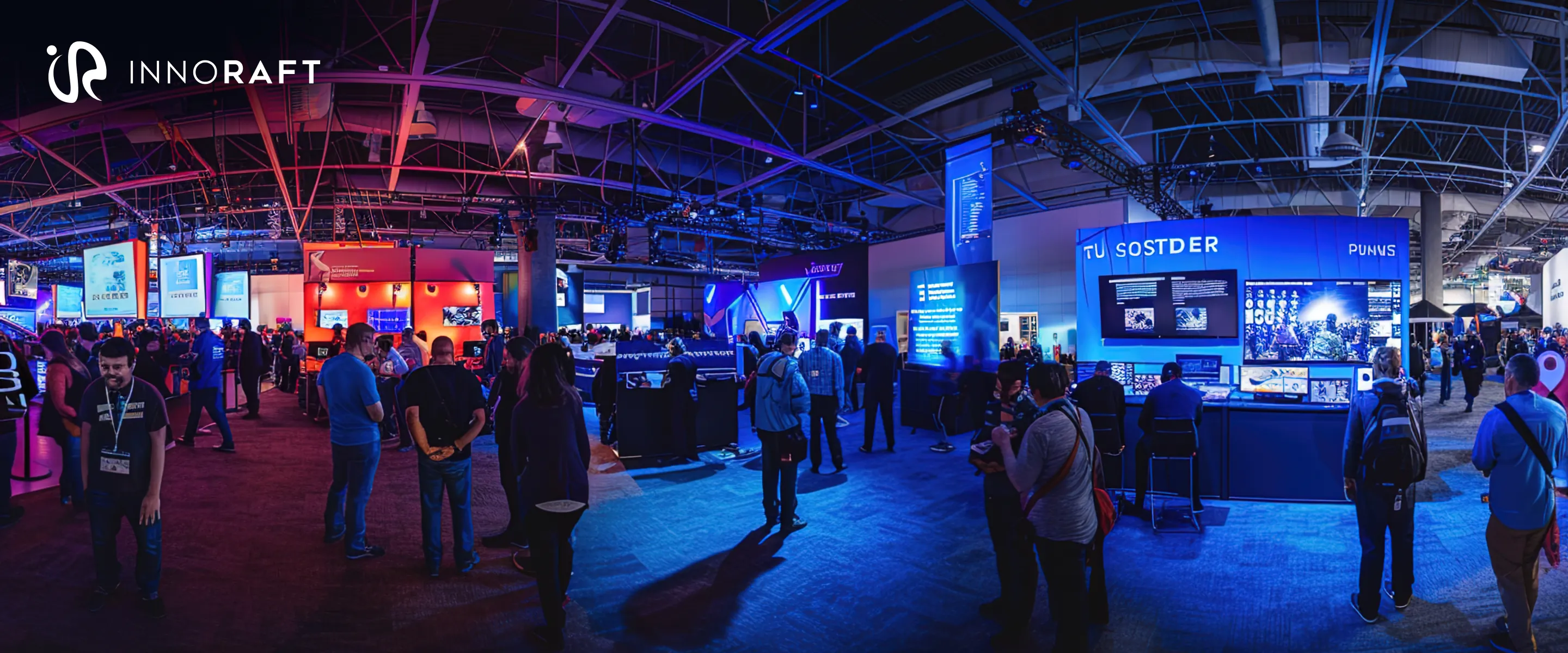Every brand needs a dedicated space that offers a unique blend of in-person and digital experiences to customers, employees, and stakeholders. These spaces, known as Digital experience hubs, can inspire, inform, and significantly influence your business success.
But building these digital+physical dedicated spaces is not just about flashy screens or generic storytelling. It's about intentional design backed by purpose-driven technology choices. Every interaction inside these immersive experience center solutions needs to reinforce the brand narrative and evolve with the business. That means scalability isn't optional; it is foundational.
That is why, at the heart of our approach lies the principle of 'Client-First Scalability'. It's not just about choosing trending tools and technologies; it's about selecting technologies that will grow and evolve with the client's CX vision, data needs, and operational scale. Every component is vetted not only for its performance but for how it contributes to a long-term, flexible ecosystem.
Instead of leveraging technology in isolation, we design digital experience hubs as living, digital ecosystems that are multisensory, interactive, and measurable. We build these dedicated spaces from the ground up with five distinct, integrated technology layers that ensure every element has a role in delivering seamless, emotionally resonant experiences.
Let us break down what each of the five layers, from the storytelling foundation to the operational backbone, and the digital experience hub tech stack that brings these layers to life.
Level 1: The Experience Design Layer: Turning Stories into Sketches
Every customer experience center starts with a story. This is where that story takes visual and spatial form. The experience design layer is the creative canvas where brand narratives are imagined, UI/UX wireframes are sketched, and customer UI/UX is shaped. It sets the tone, mood, and emotional arc of the entire journey.
This layer is all about crafting the blueprint of the visitor’s experience; what they’ll see, hear, and feel. This is where creative teams translate strategic messaging into visual scenes, including wireframes, moodboards, and UI/UX designs for effective storytelling. These modular visual storytelling elements can be later developed as templates and stitched together as visual scenes, stories, interactive flows, and sensory cues that guide the user’s path through your digital experience hub.
Whether the narrative is about a company's ESG impact, a real-time product demo, or a personalized training module, this layer ensures the message is delivered with clarity and impact.
Why It Matters
Without a strong design layer, even the most powerful tech stack can fall flat. This is the foundation that ensures consistency across every screen, installation, and interaction, aligning design intent with business goals.
It also provides a shared visual language for cross-functional teams, helping marketing, product, and technical teams work in harmony before a single line of code is written.
Our Versatile Tech Stack
We use a curated set of creative tools and pipelines to bring the experience design layer to life:
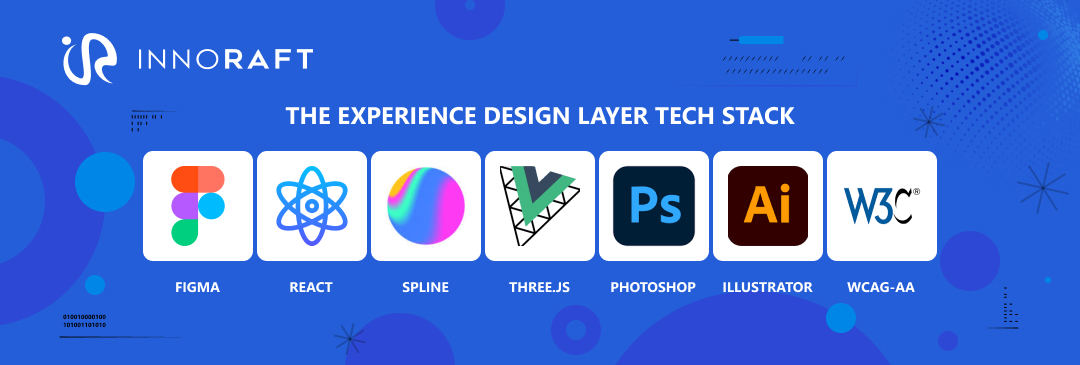
- Core workflow: An experience design with Figma and React Storybook pipeline allows us to go from static design to live components with minimal translation loss.
- Real-time web 3D: Tools like Spline and Three.js, part of our Real-Time 3D Web Development Tools, help us model and preview 3D interactions early in the design phase.
- High-fidelity graphics and generative art: Photoshop, Illustrator
- Inclusive design: WCAG-AA accessibility standards are built into our design process from day one to ensure usability for all visitors.
This layer gives shape to the story before it becomes real. It’s where creativity meets structure, setting the stage for the next layer.
Level 2: The Front-End Layer: Breathing Life Into The UI/UX Sketches
Once the design vision is clear, the next step is bringing it to life on screen. The front-end layer transforms static storyboards into dynamic, adaptive for large format screens, and touchable interfaces. This is where your visitors start interacting with your brand narrative.
From the flow of 3D product demos to gesture-based interactions, this layer is responsible for delivering seamless visual and tactile experiences that feel both intuitive and memorable, blending both digital and physical, enabled by Phygital Experience Technologies.
Why It Matters
The front-end layer is often the first and most lasting impression a visitor will have. If it’s clunky, slow, or unresponsive, it undercuts even the most thoughtful, data-rich content. But when it works well, it creates a sense of immersion that keeps people engaged and curious.
This layer also needs to perform consistently across a wide range of displays, resolutions, and devices within the experience center environment. To enrich the front-end layer of your digital experience center, our teams design microanimations, macroanimations, and strategies for front-end implementation for large-format, life-size screens. This approach is very different compared to our usual route of front-end development, ensuring there is no compromise in performance and design intent.
Our Flexible Front-End Frameworks
Our engineering teams use modern, performance-optimized frameworks that offer both flexibility and reliability:
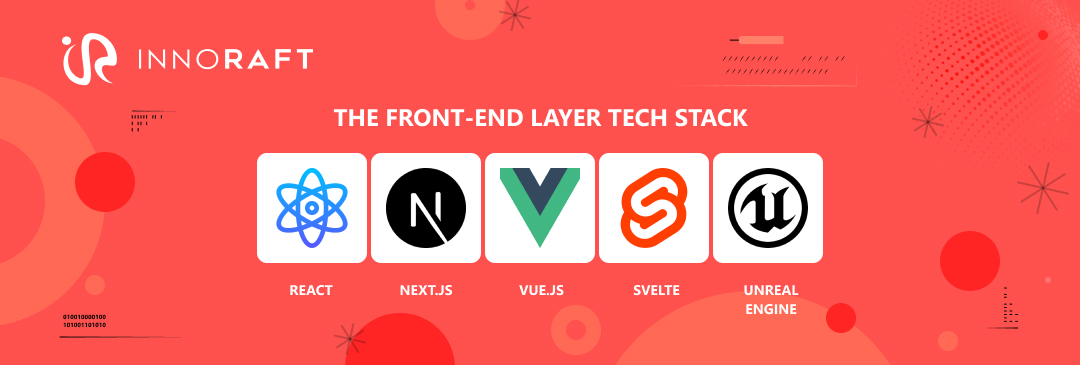
- Primary stack: React (Including React fibre) and Next.js form the core of most of our front-end builds, offering modularity and high performance for content-rich experiences
- Alternative frameworks: Vue.js, Svelte/SvelteKit
- Enhanced web 3D: Leveraging Real-Time 3D Web Development Tools like Unreal Engine for deeply interactive, browser-native visual layers
This layer is where interaction becomes real. It delivers the polish, responsiveness, and emotional connection that defines every standout customer experience center.
Level 3: The Interaction API Layer: The Central Nervous System
The interaction layer is the connective layer that links the polished digital front end with the physical environment and deeper data systems. Think of it as the central nervous system of the experience center.
When a visitor touches a screen, triggers a sensor, or moves through a space, this layer processes the input and routes it to the right destination. It makes real-time decisions about what happens next; updating visuals, syncing sound, or pulling data from the backend. This is how Phygital Experience Technologies creates fluid and responsive journeys.
Why It Matters
You can't create seamless digital-physical experiences without a bright, stable, and scalable interaction layer. This is where visitor inputs are captured, interpreted, and acted upon in real time.
It's also essential for enabling hardware-software orchestration; syncing a physical light panel with a virtual dashboard, triggering video walls via motion, or customizing content on the fly based on user profiles or behavior.
This layer also manages Experience Center API Integration, ensuring seamless communication between systems, interfaces, and connected devices.
The layer is designed for high performance, low latency, and resilience, ensuring that even the most complex interactions are executed without lag or failure.
Our High-Performing Backend Services
Our digital experience hubs are built using a mix of real-time communication protocols and scalable microservices to keep interactions fast and reliable:
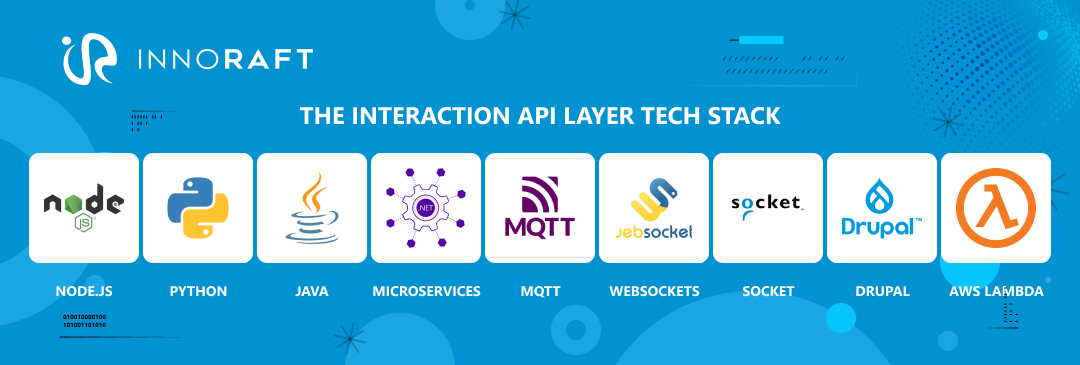
- Core services: Node.js, Python, Java, Microservices for flexible backend logic and orchestration.
- Real-time protocols: MQTT, WebSockets, Socket programming to support bi-directional, low-latency communication between front-end interfaces and physical systems.
- BE/Server level: Drupal, AWS Lambda.
This layer is what enables dynamic, immersive journeys to respond to every touchpoint. Without it, the experience center would become static.
Level 4: Customize The Experience: Power-Packed Content Management and Narrative Engine
Immersive environments need a strong operational backbone. The experience OS is that backbone. It acts as the content and narrative engine, giving your teams complete control over what stories are told, when they're told, and how they're updated across the experience center.
This layer empowers non-technical teams to manage content without relying on developers. Whether it's updating campaign visuals, launching a new product narrative, or scheduling different content flows based on audience type, the experience OS makes it simple and scalable.
Why It Matters
Customer experience centers are never static. Product lines evolve, messaging changes, and new business priorities emerge. If your content engine can't keep up, the space quickly feels outdated.
By building around Headless CMS for Experience Centers and modular content structures, this layer enables fast updates, centralized governance, and distributed control. It also supports personalization and real-time responsiveness, making it easy to tailor the experience for different audiences or moments.
Our Headless Content Management Expertise:
We offer a range of solutions depending on the client's scale, team skillset, and operational needs. All of this is grounded in Scalable Digital Experience Platforms that support growth and flexibility:
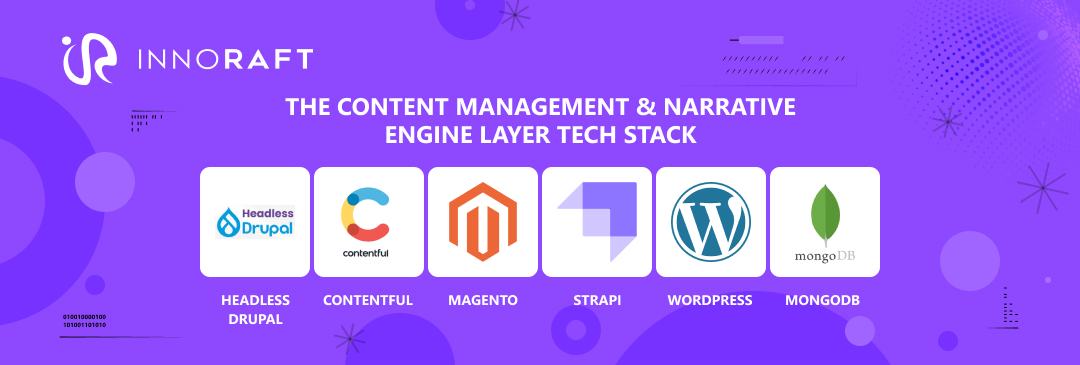
- Proven and open source: Headless Drupal for organizations looking for a robust, flexible CMS with long-term community support
- Popular SaaS platform: Contentful (Enterprise-grade, GraphQL & REST API, structured content modeling), Magento
- Self-hosted solutions: Strapi, WordPress (with REST API / GraphQL)
- Database: MongoDB
This layer gives your team the power to evolve the experience without redesigning or rebuilding the system. It's how we ensure your story can grow, pivot, and scale as fast as your business does.
Beyond the Stack: Flexibility and Partnership Built In
While technology is at the core, what truly sets our Immersive Experience Center Solutions apart is the business model that surrounds the stack. We don't just deliver a platform, we offer a long-term partnership built on flexibility, adaptability, and co-creation.
Platform Agnostic by Design
Every client has their own unique mix of cloud providers, AV systems, and IT infrastructure. Our stack is built to be platform agnostic, meaning it can integrate into any existing environment without forcing a rebuild or limiting future options. Whether you're running on AWS, Azure, or a hybrid on-prem setup, the experience center fits in without disruption, which is an essential trait of Scalable Digital Experience Platforms.
The Design–Build–Operate–Transfer Model
Our engagements follow a structured but flexible model that’s designed for long-term success:
- Design: We co-create the experience blueprint in close collaboration with your teams.
- Build: We bring the environment to life, handling everything from software to physical integration.
- Operate: We manage the systems post-launch to ensure uptime, performance, and content updates.
- Transfer: When your internal team is ready, we hand over operations with training and support.
This approach gives you the freedom to scale and evolve on your terms, with a reliable partner behind the scenes.
Ongoing Narrative Support
Our responsibility doesn’t end after deployment. Many of our clients choose to keep us on retainer for narrative drops and AI skill development. As your message changes or new capabilities emerge, we help keep your experience center fresh, relevant, and future-ready.
Conclusion: Strategy First, Stack Second
A digital experience center isn’t defined by its screens or sensors. It’s defined by how well it tells your story, engages your audience, and evolves with your business. That doesn’t happen by chance. It requires a cohesive, purpose-led strategy supported by the right technologies, layered the right way.
From immersive design and seamless phygital interactions to intelligent operations and real-time analytics, every part of our five-layer architecture serves a clear role. Each layer is modular, scalable, and intentionally chosen to support both customer experience and long-term business agility.
Our approach is simple: client-first scalability. Every tool, platform, and service is selected not just for its power, but for how it supports the journey ahead, helping us establish an accurate CX-focused tech strategy.
Key takeaways
- Experience centers are built around stories, not hardware.
- Each technology layer has a specific role, from design to operations.
- Flexibility and scalability are baked into every part of the stack.
- Our platform-agnostic approach ensures smooth integration with your existing systems.
- The design–build–operate–transfer model gives you control and continuity.
Ready to bring your brand to life in a space built for engagement, insight, and scale? Connect with our experts and start building an Immersive Experience Center Solution designed around your story.
FAQ
Frequently Asked Questions
Didn’t find what you were looking for here?
